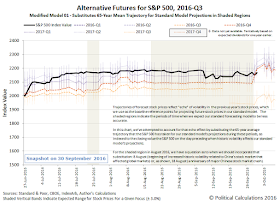The S&P 500 did little more than oscillate between 2146 and 2171 during the fourth full week of September 2016, which as far as we're concerned, means that it behaved almost exactly as expected. The following chart shows what our modified model projected as we transitioned back to our standard model during Week 4 of September 2016.
During the next couple of weeks, we expect that our standard model's projections will tend to overestimate the actual trajectory of the S&P 500 by a relatively small margin, as the historic prices we use as the base reference points from which to project future stock prices for the S&P 500 reflect a period of relatively low volatility for U.S. stock prices in the second half of 2015.
When we say "relatively small margin", we mean with respect to the period we just exited, where our standard model's projections were greatly affected by the echo of the volatility that followed the meltdown of China's stock market a year earlier. The next chart shows the latest update for our standard model's projections for 2016.
The shaded regions indicate the periods of time where we know in advance from the historic volatility of stock prices that our standard model's projections of future stock prices will likely be less accurate. Coping with those echoes of past volatility is why we developed our modified model, where we substitute trajectories that directly parallel the historic average trajectory of U.S. stock prices since 1950 for our standard model's projections.
As you can see from the first chart, that modified method appears to have been successful in anticipating the levels to which stock prices might go given how far forward in time investors are collectively looking in the just-completed period where our standard model's projections were affected by the echo effect of past volatility, but we should recognize that we had nearly optimal conditions for testing its performance, where the current year's stock market volatility was characterized by comparatively low levels of noise.
In any case, we'll soon be test driving the modified model again as we'll once again be entering a period where the echoes of past volatility will affect the accuracy of our standard model's projections.
- Monday, 26 September 2016
- Tuesday, 27 September 2016
- Wednesday, 28 September 2016
- Fed's Kashkari, echoing Yellen, says U.S. economy has room to run
- First headline: Wall Street rises as energy, financial stocks gain. Second headline: "Wall Street drops as healthcare stocks weigh". Third headline: "Wall Street rallies as OPEC reaches output deal"
- Oil soars 6 percent as OPEC reaches deal to limit output in November - see also OPEC agrees to limit oil output at 32.5 million barrels per day
- Fed's Mester says keeping rates too low risks causing future recession
- Thursday, 29 September 2016
- Oil gains, energy shares buoy global stocks; yen slides
- Wall Street dragged down by Apple, health stocks. Headline after market close: "Wall Street falls sharply on worries about banks"
- Oil rises close to $50/bbl; doubts on OPEC plan cap gains
- Friday, 30 September 2016
- Fed's Kaplan scours for signs of economy overheating, finds nothing
- Wall Street rallies, led by Deutsche Bank, financials - and yet, can only end the week just 3.58 points (0.00165%) higher than it closed in the previous week.
Elsewhere, Barry Ritholtz summarizes the week's economics and markets news in terms of its positives and negatives.

